Overview: I found Transistor.fm as an easy-to-use podcast hosting platform. Even its “Starter” plan at $19 per month lets you host unlimited podcasts, including private podcasts. Some of its notable features are a website builder, integrations with newsletter software, podcast analytics tools, and a visually appealing podcasting player. Oh, and it also has helpful customer support.
You can take a 14-day free trial of Transistor.fm using my affiliate link.
Pros:
- Modern and intuitive user interface
- Lets you host unlimited shows of unlimited length (including private podcasts)
- Responsive and knowledgeable customer support
- Streamlined distribution across directories in a single click
Cons:
- Expensive than other beginner podcast hosting platforms
- Some of its features, like dynamic content, aren’t available in its cheapest tier
- Doesn’t offer video podcasting
A relatively new entrant in the podcast hosting market, Transistor.fm has quickly found a foothold. How is its user experience? Is it fit for your podcasting needs? Today, I’ll review Transistor.fm podcast hosting platform in detail to help you decide.
Here’s a video review of the platform if you prefer that:
What is Transistor.fm?
It’s a podcast hosting and analytics platform with a modern user interface. It lets you distribute your podcast across popular directories in a streamlined manner and even host private podcasts for an exclusive group of listeners.
I Found Publishing a Podcast With Transistor.fm Pretty Straightforward…
Once you sign up for a new Transistor.fm account (requires your credit card information), you’ll see a visually appealing and intuitive dashboard.
Click on the “Add Your First Show” button to start a new podcast. You also have the option to import your existing podcast or create a private podcast.
On the next screen, you’ll need to enter some basic info about your podcast: its title, description, podcast artwork, primary category, etc. For private podcasts, you can safelist domains for sending invite links, draft a custom welcome email, and password protect your episodes.
Uploading your first episode is also simple. You give your episode a title, upload an audio file, give an episode number, choose if it’s normal, bonus, or trailer, and add your show notes. You can publish the episode immediately, schedule it for later, or keep it saved as a draft.
Podcast Distribution is Also Streamlined…
Once you’ve published an episode and taken care of the basics for your show, you get one-click “Submit my show” buttons to distribute your podcast’s RSS feed to popular directories such as Spotify, Amazon Music, and others.
For Apple Podcasts and Google Podcasts, the submission is a longer process, so it offers prompts to set appropriate expectations and support documentation.
Transistor.fm Podcast Hosting Pricing
Transistor offers three pricing plans capped by the number of monthly downloads. While it doesn’t offer free plans, you get a 14-day free trial on all the plans. All the plans offer you unlimited storage, so you can start as many podcasts as you like without any constraint on their length. Here are the three pricing tiers:
- Starter: $19 per month for up to 20k monthly downloads
- Professional: $49 per month for up to 100k monthly downloads
- Business: $99 per month for up to 250k monthly downloads
On all the plans, you only the price of 10 months if you pay for the whole year upfront.
Unique Transistor.fm Features I Liked…
While I’ll cover the usual podcasting features of the platform later, I want to first cover the things that stood out to me.
The podcast hosting was built around 2017-2018, so the platform has a contemporary interface. It has most of the features present in its competitors, like Buzzsprout, but with a better user interface.
I also like its analytics. Besides high-level listener trends and average podcast downloads per episode, you can also get the estimated number of people who subscribe to your podcast. If you’re feeling nerdy, there’s an episode breakdown table that you can export as a CSV file and analyze your most popular ones.
A Small Team Powers Transistor.fm’s Helpful Customer Support
I love that there’s an intimate team of four people behind the platform. They care about the customers and are always willing to support their customers.
Photo from the company’s About Page
It helps that one of their founders, Jon, had hosted his own podcast before. He replied to my queries over email a couple of times I got stuck. They also have live customer support and a help desk with in-depth guides.
What I Dislike About Transistor.fm
Lacks Video Podcasting Capabilities
Given, it has above average pricing, I would expect to be able to host video podcasts on the platform. But Transistor only lets you embed your YouTube videos on your podcast website alongside the audio.
Dynamic Features Are Limited to Its Higher Price Tiers
I also don’t like that its “dynamic ads” and “dynamic show notes” features are only available starting in its professional tier — which has a steep price of $49 per month. Another minor annoyance is you can’t remove Transistor’s branding unless you’re at least on their Business tier.
But Transistor.fm Excels in Standard Podcasting Features
There’s more to Transistor than just being a podcast hosting platform. Let’s look at the perks you get alongside storage space:
Your Podcast Website
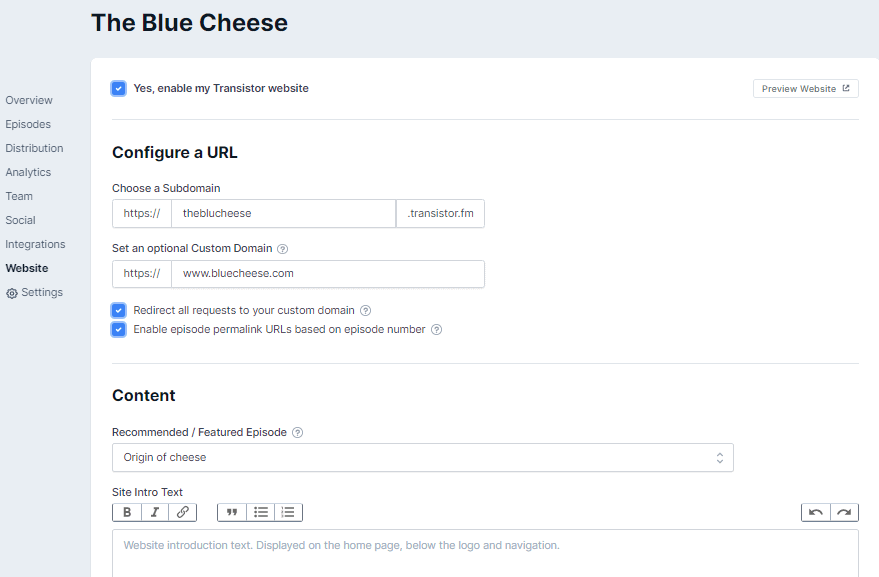
If you don’t have a website already, you can create one with Transistor. Choose a subdomain or set an optional custom domain.
Design your website by adding favicons, social sharing images, text and player colors, etc. Add your Google Analytics and Fathom Analytics ID to track the page views. You can also include custom CSS to override any default styles on your site.
Embedding Podcast
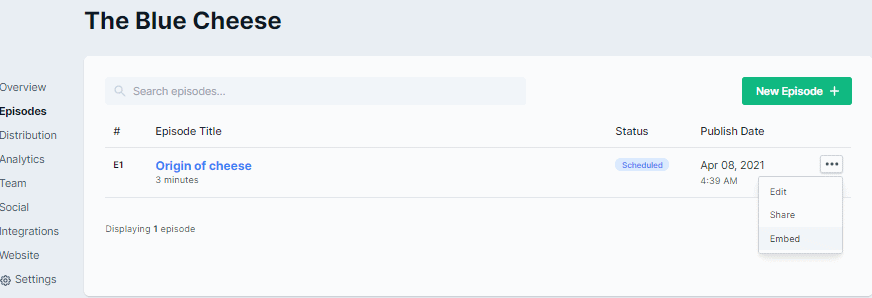
All your episodes have a default sharing and embedding option. Click on the three dots at the side of every episode and select the embed option. Copy the link and paste it on your website.
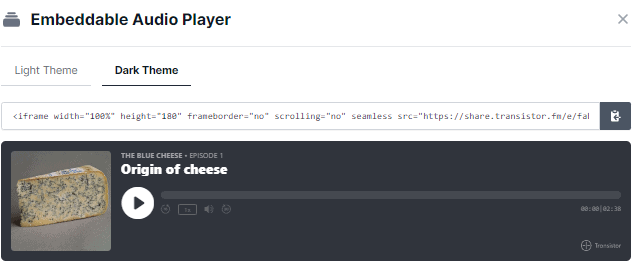
There two-player themes: Light and Dark. Choose the theme that goes well with your overall podcast style. The players are intuitive and each of them has three buttons- subscribe, share, and more info making mini players more responsive and easy to share.
Apple Podcasts, Spotify, etc are podcast players not hosting platforms. When you click on download or subscribe in these apps, they’ll send the request to Transistor (host). The podcast player will then download the MP3 file from the server.
Analytics
Transistor.fm has hands down the best analytics section. It pulls the data from all the podcast directories every morning. Access to such data helps you understand the shortcomings and reach a bigger audience.
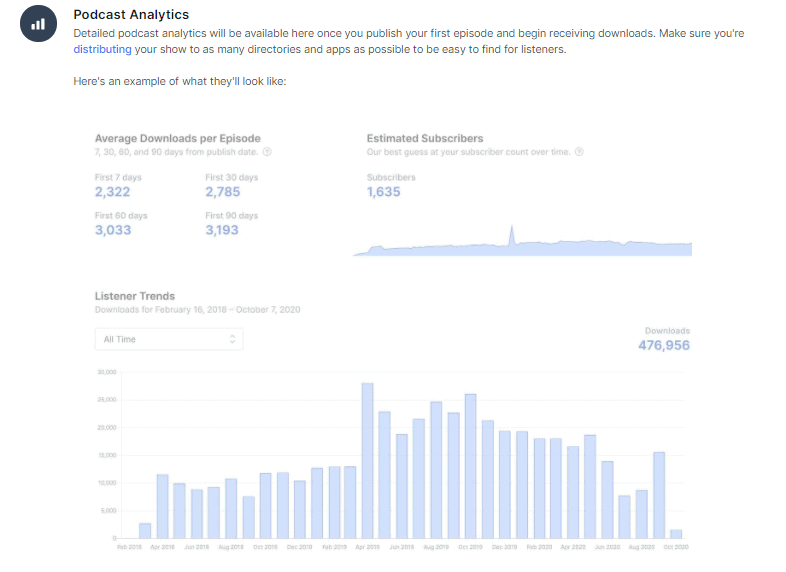
If you are a person with little to no idea about gauging analytics, Transister deconstructs it for you in a way that even a baby could understand. Okay, that was a bit of a stretch, but you get the point.
It tells you the number of downloads, estimated subscribers, listener trends, etc. It also allows you to filter your episode by popularity so that you know the kind of content your listeners enjoy. Additionally, you can also know which podcast app most of your listeners use and visualize where they live by looking at the Transistor’s map.
Moreover, you can set up 3rd party analytics like Chartable, Podtrack, Podsights, Polycom, etc in the advanced settings.
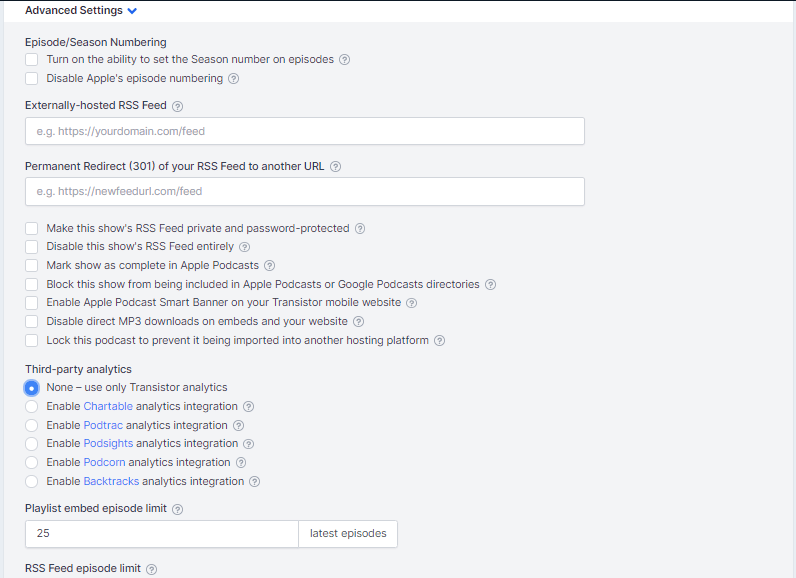
Transistor.fm follows IAB guidelines. This means, they eliminate duplicate downloads, downloads from search indexes, and any download that comes from a bot in the analysis you see on Transistor.
Private Podcasting
Like I mentioned in the beginning, this podcast hosting app lets you create a private podcast. This is a useful feature if you want a selected audience or you are running a business and use podcasting as a mode of communication with your employees.
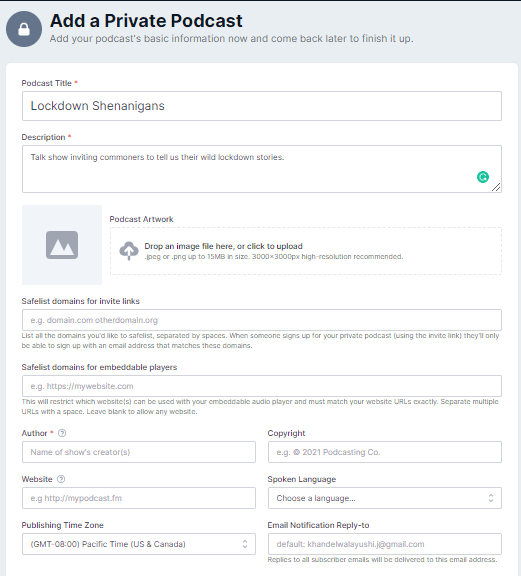
The process of creating a private podcast is the same except for additional details. Add domains to invite links and embeddable players.
Since it’s a private podcast, you can always remove the listeners you don’t want as your audience and deny access. Further, Transistor.fm lets you have full ownership of your podcast and retains 100% rights reserved even in the public podcast. So you can run your own ads on it.
It’s also possible to transfer the ownership as well.
Importing Your Podcast

If you already have a podcast on other platforms, Transistor.fm needs a link to your apple podcast RSS feed or you can directly search for your podcast.
Before importing your podcast, you’ll get a mail from Transistor.fm for validation. If successful, you’ll find your podcast on Transistor.
How Transistor Stacks Against Its Competition
Transistor.fm Vs. Buzzsprout
Transistor.fm beats Buzzsprout for its modern and intuitive interface and the ability to host unlimited shows of unlimited length. It’s made for enterprises and may offer a more realistic listening experience
Buzzsprout, however, is cheaper at $12 per month with 3 hours of audio upload. It’s sufficient for most beginner podcasters. It also lets you add dynamic content to your new episodes or your episode history in all of its plans.
With the recent introduction of Buzzsprout Subscriptions, you can also accept payments on your Buzzsprout podcast website. The platform also lets you monetize via Buzzsprout ads — while Transistor only lets you monetize your podcast by integrating with third-party tools.
Here’s my detailed Buzzsprout review that you may want to check out.
Final Thoughts
Apart from the absence of a recording feature, Transistor has many key features like unlimited podcast creation, collaborative options, advanced analytics, built-in website, easy distribution, 100% ownership of the channel, etc which are not found in most of the other podcasting services.
Even the pricing is affordable for new as well as established podcasters or businesses. With so many benefits it’s easy to overlook a few flaws. It’s simple, effective, and easy to use. Be sure to give it a try, you may find yourself liking it more than your go-to podcasting service.